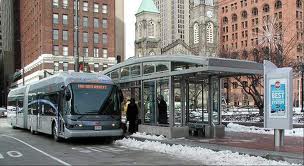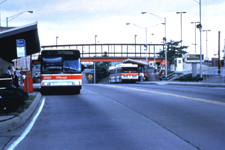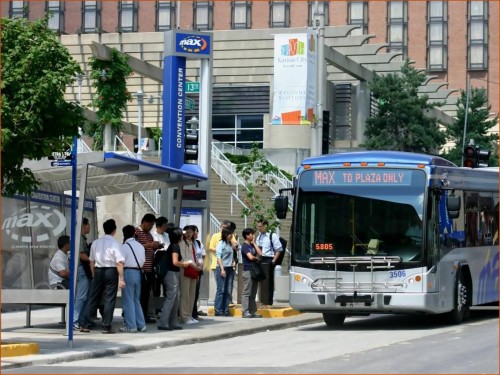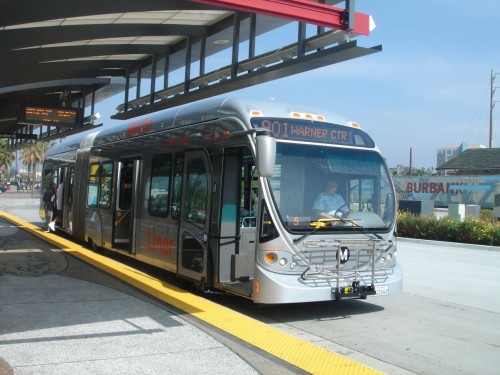Now that SEA 176, better known as the mass transit bill, has been signed into law, the real work begins for transit advocates to push support for the Indy Connect plan. As we all know, SEA 176 prohibits light rail. It does not, however, prohibit heavy rail or commuter rail. But that’s another post for another time. The only alternatives studied by mass transit planners were light rail and bus rapid transit. Therefore, to complement the plan’s enhanced regular bus system, the five proposed rapid transit routes will be bus rapid transit (BRT).  BRT, as defined by the National BRT institute, is “an innovative, high capacity, lower cost public transit solution that can significantly improve urban mobility.â€Â That innovation and high capacity is achieved through usage of specialized vehicles on roadways or dedicated lanes, which allows for quick, efficient transport of passengers. Many opponents of BRT don’t see how BRT can be as effective in moving large amounts of people as rail transit. Others don’t believe BRT can produce enough transit oriented development (TOD) to warrant the investment. And some just don’t see BRT as attractive as rail. However, BRT, when done right, can do all of those things. While there are multiple examples of BRT around the U.S., the following five cities have well built BRT systems and could give us a glimpse of what Indy Connect is hoping to do here in Indianapolis.
1. Health Line: Cleveland, OH
Cleveland has set the standard of what BRT is supposed to be here in the U.S. This line is the highest rated BRT line in the U.S. according to the Institution for Transportation and Development Policy. Debuting in 2008, in a city that already has commuter rail and heavy rail transit, Cleveland’s Health Line is the city’s only BRT line. The line is 9.2 miles in length and runs along Euclid Avenue from downtown Cleveland to East Cleveland in an exclusive right-of-way. Each vehicle used seats 47 people and holds 53 more standing. Running 24-hours, it has a peak frequency of 5 minutes during rush hours and 30 minute frequency during overnight hours. The line cost $200 million but has generated $5.8 billion in development.

2. EmX Line: Eugene, OR
The EmX Green line is a full featured BRT system with exclusive bus lanes, high-capacity vehicles, near level boarding, eight stations, and off-board fare collections. The route is four miles in length and connects downtown Eugene to downtown Springfield, while serving the University of Oregon. The route has a peak frequency of 10 minutes, which is an upgrade from 15-30 minutes among the previous standard bus service. Weekend headways are 15 – 20 minutes. The cost of the project was $25 million to build, including the purchase of six vehicles. The Federal Transit Administration funded 80% of that amount. Riders note that the service not only provided increased frequency, but enhanced reliability as well. Ridership increased from 4,000 in its 2007 debut to 5,400 a year later and has been increasing steadily since. The route also saw an increase in choice ridership with 16 percent of users previously relying on car usage. Within its first year, the line was awarded a Sustainable Transport Honorable Mention by the Institute for Transportation and Development Policy (ITDP) for its “green†image.    The line has generated interest in land development. Local firms have attributed increased interest in certain properties relative to their proximity to the BRT line. The region’s Lane Transit District recently opened its second EmX corridor known as the Gateway EmX Extension running 7.8 miles linking Springfield to Sacred Heart Medical Center at RiverBend.

3. Busway System: Pittsburgh, PA
Pittsburgh’s Busway system has helped the city’s mass transit system grow to being the 14th largest urban mass transit system in the U.S. In a city with 25 miles of light rail transit, the 18.5 mile Busway system is comprised of three corridors: the South Busway, East Busway, and West Busway. The South busway runs for 4.3 miles from the Mt. Washington Transit Tunnel from downtown to the Overbrook neighborhood. The East busway is 9.1 miles in length running from Swissvale to downtown. The West busway runs 5.1 miles from the shore of the Ohio River near downtown to Carnegie. The Pittsburgh busway was the first BRT system in the U.S., opening in 1977. The East busway has seen the most success with two minute headways and attracting $300 million in development within its first 15 years of operation. The system as a whole does have some drawbacks with its lack of advance fare collection, elevated boarding platforms and light rail style stations. However, what it lacks in amenities, it makes up for in travel options, as all lines run on exclusive two-lane highways directly into the city’s downtown.

4. MAX: Kansas City, MO
Kansas City is the one city out of the list that is most comparable to Indianapolis, with a BRT system like the one that Indy Connect has planned. The system currently consists of two operating lines, one under construction, four planned for the future. The system runs 7 days a week from 4:00 am to 1:00 am with 10 minute headways during rush hour and 15 – 30 minute headways during all other times. The system consists of 3.75 miles of exclusive transit lanes, 40 stations, and 28 vehicles. The Main Street Max or Orange line runs nine miles from the city market at 3rd and Grand to 75th and Wornall Rd. This line cost $20.9 million. The line has achieved high ridership, including choice riders, with 6,000 daily riders. The Troost Avenue Max, or Green line, is 13 miles in length running from 11th and Wyandotte to Bannister and Drury. This route sees 7500 riders daily. The capital costs were $30.7 million which included 15 vehicles, stations, and park and ride lots. 80% of the total project costs were paid for by the Federal Transit Administration. Both corridors have seen increasing interest in land development with community improvement districts, medical center and university expansions, and new housing developments.

5. Orange Line: Los Angeles, CA
As mentioned in a previous post, the Orange line in LA can be most easily compared to the proposed Green line here in Indianapolis. The Orange line opened in 2005, operating as a busway in an abandoned railroad corridor. While light rail was studied for the corridor, the California legislature passed a bill which “prohibited the construction of any above-ground rail transit project†along the corridor. The Orange line proved to be just as successful as any new LRT project with 14 stations, automated ticket machines, and park and ride facilities. A 2007 study compared the Orange line to LA’s Gold line light rail service and found that the BRT system performs better due to the fact that it carries more passengers and cost significantly less. The line achieved ridership projections for the year 2020 within seven months of its debut. A 2006 survey found that the line attracted choice users as well, with 18% of riders having switched from their cars to BRT.
- photo credit: LA Orange Line; wikipedia.org
With standards measured for BRT categorized as gold, silver, or bronze, of the seven authentic BRT lines in the U.S., none reach gold standard, the Health Line ranks Silver, and Pittsburgh’s East busway ranks bronze level. Maybe Indy Connect’s Green line along the Northeast corridor could reach beyond those levels. Perhaps a few years after opening, transit planners may see a need to upgrade the Red line to an exclusive right-of-way from Carmel to Greenwood, instead of toggling back and forth between transitway and mixed traffic. With the plans for East Washington Street, the Blue line could definitely spur development along that corridor, and enhance the scenery out west, once the end towards the airport is complete. The constant travel along Keystone Avenue and 38th street give a vision of numerous possibilities of what could be with the Orange and Purple lines respectively. The success of the aforementioned BRT systems provides a model for Indianapolis and central Indiana to follow. If they can do it, why can’t we?
References:
http://www.indyconnect.org
http://greatergreaterwashington.org/post/17389/the-us-has-only-5-true-brt-systems-and-none-are-gold/
Clough, Craig. (Oct. 2013). City council supports building light rail on orange line bus route. Sherman Oaks Patch. Retrieved from http://shermanoaks.patch.com/groups/politics-and-elections/p/city-council-supports-building-light-rail-on-orange-line-bus-route
Deng, T. (2011). Recent developments in Bus Rapid Transit: A review of the literature. Transport Reviews, (31)1, pgs 69-96.
Jaff, Eric. (2011). What we can learn from city Busways. The Atlantic Cities. Retrieved from http://www.theatlanticcities.com/commute/2011/12/best-big-city-busways/764/
Kansas City’s MAX Bus Rapid Transit System. Retrieved from http://www.nbrti.org/docs/ppt/Broward%20County%20BRT%20Workshop/Kansas_City_MAX.pdf
McMahon, Jeff. (2013). Bus Rapid Transit spurs development better than light rail or streetcars. Forbes. Retrieved from http://www.forbes.com/sites/jeffmcmahon/2013/09/15/bus-rapid-transit-spurs-development-better-than-light-rail-and-streetcars/
Peterson, Sarah Jo. (2012). GAO Report on Bus Rapid Transit finds success stories. Infrastructure Initiative. Retrieved from http://uli.org/infrastructure-initiative/gao-report-on-bus-rapid-transit-finds-success-stories/
Schmitz, Jon. (2013). Pittsburgh’s East Busway rapid transit system ranks ‘bronze’. Pittsburgh Post-Gazette. Retrieved from http://www.post-gazette.com/local/city/2013/05/02/Pittsburgh-s-East-Busway-rapid-transit-system-ranks-bronze/stories/201305020299
The EmX Franklin Corridor BRT Project Evaluation. Final Report (April 2009). Retrieved from http://www.nbrti.org/docs/pdf/EmX_%20Evaluation_09_508.pdf
Photo References:
http://www.indyconnect.org/UserFiles/Image/General-Bus-Frequency-Map.png
http://www.gazette.net/storyimage/PN/20120613/NEWS/706139585/AR/0/AR-706139585.jpg
http://www.wildish.com/sites/default/files/EmX%20Rapid%20Bus%20Photo_0.jpg
http://www.fta.dot.gov/images/PATBSWY.jpg
http://upload.wikimedia.org/wikipedia/commons/e/e7/LA_metro_liner_with_bicycle_rack.jpg

Grand Rapids, MI, is building BRT right now. It’s a good example of who to ask to pass transit millages. It’s only a 3 city project there, not even covering the entirety of Kent County, yet may still have the impact of the Healthline from a length impact standpoint.
Side not on the Healthline, I’ve ridden it and it is very timely and efficient for the rider, but the medians they installed and having stations only at intersections make it impossible to cross Euclid now as a pedestrian unless you’re at an intersection, which is very inconvenient given the location of the Warehouse district and other entertainment areas.